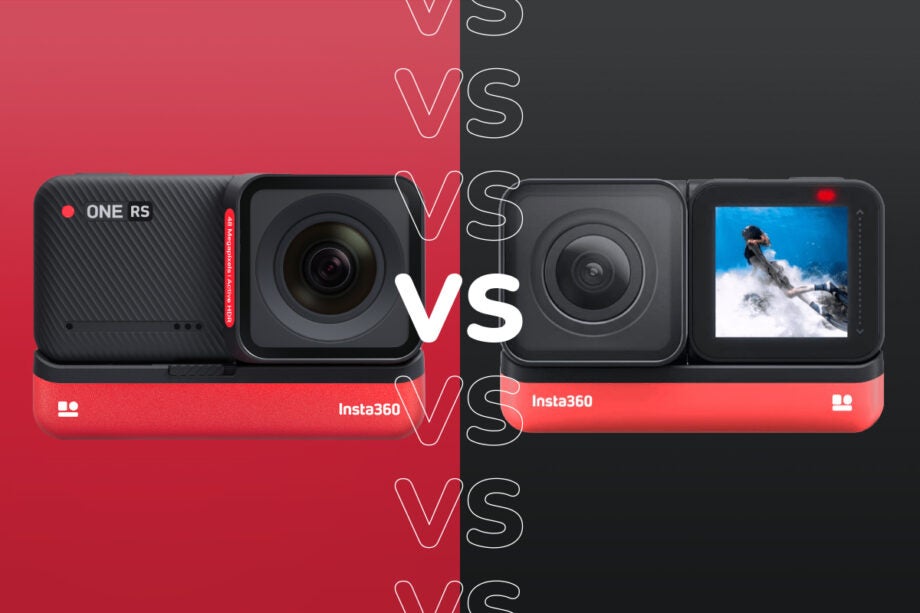Insta360 One RS vs Insta360 One R: All you need to know

More than two years since its release, Insta360 has just unveiled the true successor to the One R action camera, and there are a ton of key differences worth knowing about if you want to upgrade.
The Insta360 One R caught our attention thanks to its modular design, the likes of which we’ve since seen replicated in other action cameras like the DJI Action 2, and that same concept of swapping out pieces and changing configurations still remains an essential part of the Insta360 One RS.
Even though the One R and the One RS look almost identical (thanks in part to the latter’s backwards compatibility), there are some major changes that have taken place under the hood. Keep reading on to know exactly how these two cameras differ.
It’s also important to note that while we have fully tested the Insta360 One R, we’ve only spent limited amount of time with the Insta360 One RS, so we won’t be going too deep into their differences until we can do a full comparison of both cameras.
Video Quality
Starting off with what we already know, the One R can film in multiple resolutions, with the max frame rate hitting 200fps at 1080p, and the middle-ground 2.7K resolution hitting 100fps. You can also shoot in 4K at 30 or 60fps, for scenes where you’re looking for the most detail.
There is support for HDR, with Time Lapse and TimeShift modes available, although our review noted that the time-lapse feature was a little unpredictable, with our frames coming out fatally overexposed even when filmed in low light.
You can change the One R’s field of view, with options between ultra-wide, wide, linear and narrow views.
Ultimately, we noted that the video quality for the One R was solid, but was not as good as some other handheld cameras out there, like the GoPro Max.
Moving onto what’s new, the One RS can film in 6K at either 24 or 25fps, which is a huge jump in resolution when compared to its predecessor, and you still have the option to film in 4K at 60fps. The 6K Widescreen mode is an addition to the One RS, as it outputs high-resolution 6K footage with a 2.35:1 ratio for a cinematic wide-screen.

The new feature, Active HDR, also ensures that the camera stays stable even as you are moving, minimising ghosting and revealing the smaller details in a shot that might get missed.
Moreover, the One RS features FlowState Stabilisation, which is now activated during filming as opposed to being applied in post. Enhanced stabilisation allows for users to share wide-angle content without needing to process the footage in the Insta360 app, with the design allowing for the footage to always stay level.
In the same vein as the One R, you can use the One RS to film a 5.7K video at 360-degrees when the 360 module is installed. 360 filming gives you the option to pick out your favourite angles and export them as a flat video, for more accessibility.
Stills
Looking at the image quality, our review noted that the image quality of the Insta360 One R was good, but lacking in some areas. Our main issue with the camera stems from frame blurring in lower light or higher motion, which leads to blurred textures and softened detail during movement that can ruin images.
The Insta360 One RS seems to have improved over its predecessor, packing a 48-megapixel lens instead of the previous 12MP. More megapixels will allow for more detailed shots that will still look sharp after you zoom or crop the image, meaning that the One RS will capture generally better pictures than the One R.
Audio
The Insta360 One R has two microphones, with our review noting that the spatial information captured can be limited. We also noted that it could sound a little flat, with the tone capture being fairly bright, which can result in captured audio feeling noisier than it was in reality.
The One R does support an external microphone, however, there is no 3.5mm headphone jack but a USB-C adaptor you can buy from Insta360.

Moving onto the Insta360 One RS, there are now three microphones instead of two, with audio modes like Wind Reduction, Directional Enhancement and Stereo, giving users more choice.
Insta360 claims that the extra microphone offers up true-to-life sound, while the new mounting bracket features a windproof panel to dispel unwanted background noise.
Accessories
One of the interesting things about the One R was its modular design, which has been kept by the One RS. However, the One R mounting case was difficult to take on and off, as noted in our review, and since there are no mounting points on the camera itself, a mounting case is needed for more dynamic shots.
The One RS has a redesigned mounting bracket that has a quick-release button, meaning that you can trade out lenses on the go, making it a lot more accessible than its predecessor.
Both cameras can be used with the Insta360 Invisible Selfie Stick, which doesn’t get capturedwe during 360 filming to create a drone-like effect.
Furthermore, the new lens and Core can be used with the One R as well as the One RS, meaning that users have the choice of a slow camera upgrade if they don’t want to buy a new camera outright.
Early verdict
Until we spend the proper amount of time testing out the Insta360 One RS, a definitive conclusion just isn’t possible but there’s certainly a lot to get excited about. The improvements to megapixel count, resolution and audio quality, just to mention a few, will no doubt be a tempting offer for anyone looking to upgrade from their One R.








